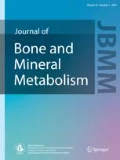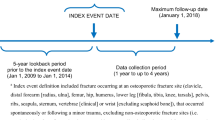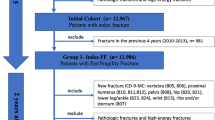Abstract
Re-fracture risk is higher following osteoporotic fracture. However, there is no accurately reported rate of re-fracture incidence in southwest China. The purpose of this study was to describe the osteoporotic vertebral fracture (OVF) survival for re-fracture state and analyze the risk of re-fracture. This historical cohort study was conducted in four hospitals in southwest China. Patients aged ≥ 50 years (n = 586) with OVF who were supposed to receive anti-osteoporosis drugs after the fracture were included (2012–2017). Telephone follow-up and referring case files were used to estimate the survival for re-fracture and identify the determinants of re-fracture. A total of 555 patients completed the follow-up investigation. Overall, 285 patients experienced a re-fracture, and the longest follow-up investigation time was 72 months. The survival rates for re-fracture at 12 months, 24 months, 36 months, and 48 months were 82.0%, 71.5%, 61.7%, and 34.0%, respectively. The factors correlated with re-fracture hazard were advanced age [hazard ratio (HR) = 1.996], being female (HR = 1.342), smoking (HR = 1.435), history of hypertension (HR = 1.219) and diabetes (HR = 3.271), and persistence of taking anti-osteoporosis drugs after fracture [0–3 months, 4–6 months, 7–12 months, and more than 12 months (HR = 0.703)]. OVF patients with advanced age, who were female, smoked, had fracture with hypertension or diabetes, and who complied poorly with anti-osteoporosis drug treatment presented higher prevalence of re-fracture and low anti-osteoporosis adherence in southwest China. The management of anti-osteoporosis after fracture is necessary in this area.
Similar content being viewed by others
Change history
02 April 2019
In the Original publication of the article, the funding ID has been incorrectly published as (815602390) in the Acknowledgements.
References
Oden A, McCloskey EV, Kanis JA, Harvey NC, Johansson H (2015) Burden of high fracture probability worldwide: secular increases 2010–2040. Osteoporos Int 26:2243–2248
Lindsay R, Silverman SL, Cooper C et al (2001) Risk of new vertebral fracture in the year following a fracture. JAMA 285:320–323
van Geel TA, van Helden S, Geusens PP, Winkens B, Dinant GJ (2009) Clinical subsequent fractures cluster in time after first fractures. Ann Rheum Dis 68:99–102
Gibson-Smith D, Klop C, Elders PJ et al (2014) The risk of major and any (non-hip) fragility fracture after hip fracture in the United Kingdom: 2000–2010. Osteoporos Int 25:2555–2563
Raebel MA, Schmittdiel J, Karter AJ, Konieczny JL, Steiner JF (2013) Standardizing terminology and definitions of medication adherence and persistence in research employing electronic databases. Med Care 51:S11–S21
Huybrechts KF, Ishak KJ, Caro JJ (2006) Assessment of compliance with osteoporosis treatment and its consequences in a managed care population. Bone 38:922–928
Qaseem A, Forciea MA, McLean RM, Denberg TD (2017) Treatment of low bone density or osteoporosis to prevent fractures in men and women: a clinical practice guideline update from the American College of Physicians. Ann Intern Med 166:818–839
Center JR, Bliuc D, Nguyen TV, Eisman JA (2007) Risk of subsequent fracture after low-trauma fracture in men and women. JAMA 297:387–394
Dinh MM, Berendsen RS, Bein KJ et al (2016) Statewide retrospective study of low acuity emergency presentations in New South Wales, Australia: who, what, where and why? BMJ Open 6:e10964
Ganda K, Schaffer A, Seibel MJ (2015) Predictors of re-fracture amongst patients managed within a secondary fracture prevention program: a 7-year prospective study. Osteoporos Int 26:543–551
Lih A, Nandapalan H, Kim M et al (2011) Targeted intervention reduces refracture rates in patients with incident non-vertebral osteoporotic fractures: a 4-year prospective controlled study. Osteoporos Int 22:849–858
Muheremu A, Peng C, Zhongyan W, Min J, Xinling W (2013) Study on the effect of systematic osteoporosis treatment on the incidence of second fracture and mortality in elderly patients with fracture. J Shanxi Med Univ 44:638–640
Tang G (2011) The risk factors of re-fracture assement in eldly osteoporosis fracture patients[D]. Guangzhou Medical School, Guangzhou
Ye Z, Lu H, Liu P (2017) Association between essential hypertension and bone mineral density: a systematic review and meta-analysis. Oncotarget 8:68916–68927
Li C, Zeng Y, Tao L et al (2017) Meta-analysis of hypertension and osteoporotic fracture risk in women and men. Osteoporos Int 28:2309–2318
Thorin MH, Wihlborg A, Akesson K, Gerdhem P (2016) Smoking, smoking cessation, and fracture risk in elderly women followed for 10 years. Osteoporos Int 27:249–255
Kanis JA, Johnell O, Oden A et al (2005) Smoking and fracture risk: a meta-analysis. Osteoporos Int 16:155–162
Tian L, Yang R, Wei L et al (2017) Prevalence of osteoporosis and related lifestyle and metabolic factors of postmenopausal women and elderly men: a cross-sectional study in Gansu province, Northwestern of China. Medicine (Baltimore) 96:e8294
Xiaoyu M, Tong H, Nayin C (2008) Prevalence of smoking and drinking among chronic diseases surveillance population in Guangxi. Pract Prev Med 15(5):1600–1601
Xiaoyu M, Nayin C, Hong Y, Yuanyuan W, Ying H, Tong H (2011) Investigation on smoking and passive smoking and smoking cessation among urban and rural residents in Guangxi. Chin J Prev Contr Chron Dis 19(2):206–207
Scolaro JA, Schenker ML, Yannascoli S, Baldwin K, Mehta S, Ahn J (2014) Cigarette smoking increases complications following fracture: a systematic review. J Bone Joint Surg Am 96:674–681
Xiaoyun B, Xiufen H, Qinghui Z et al (2016) Characteristics of body composition and the correlation with bone mineral density in middleaged and older Zhuang people in Baise. Chin J Osteoporos 22:183–206
Hernlund E, Svedbom A, Ivergard M et al (2013) Osteoporosis in the European Union: medical management, epidemiology and economic burden. A report prepared in collaboration with the international osteoporosis foundation (IOF) and the european federation of pharmaceutical industry Associations (EFPIA). Arch Osteoporos 8:136
Kim H, Baek KH, Lee SY et al (2017) Association of circulating dipeptidyl-peptidase 4 levels with osteoporotic fracture in postmenopausal women. Osteoporos Int 28:1099–1108
van Geel TA, van Helden S, Geusens PP, Winkens B, Dinant GJ (2009) Clinical subsequent fractures cluster in time after first fractures. Ann Rheum Dis 68:99–102
Esses SI, McGuire R, Jenkins J et al (2011) The treatment of symptomatic osteoporotic spinal compression fractures. J Am Acad Orthop Surg 19:176–182
Reyes C, Tebe C, Martinez-Laguna D et al (2017) One and two-year persistence with different anti-osteoporosis medications: a retrospective cohort study. Osteoporos Int 28:2997–3004
Martin-Merino E, Huerta-Alvarez C, Prieto-Alhambra D, Montero-Corominas D (2017) Cessation rate of anti-osteoporosis treatments and risk factors in Spanish primary care settings: a population-based cohort analysis. Arch Osteoporos 12:39
Acknowledgements
This research was supported by the Fuxing Nursing Scientific Research Fund of Fudan University (FNF201708) and the National Natural Science Foundation of China (815602390). The research group thanks the patients who participated in this study. In addition, we thank Zhang Xianyan, Huang Chengjing, He Shiyuan, and Lv Shouqiang of Youjiang Medical University for Nationalities, who assisted with the study.
Author information
Authors and Affiliations
Corresponding author
Ethics declarations
Conflict of interest
No benefits in any form have been received or will be received from a commercial party related directly or indirectly to the subject(s) of this article.
Ethical approval
All procedures performed in studies involving human participants were in accordance with the ethical standards of the institutional and/or national research committee and with the 1964 Helsinki Declaration and its later amendments and/or comparable ethical standards.
Informed consent
Additional informed consent was obtained from all individual participants for whom identifying information is included in this article.
About this article
Cite this article
Ma, X., Xia, H., Wang, J. et al. Re-fracture and correlated risk factors in patients with osteoporotic vertebral fractures. J Bone Miner Metab 37, 722–728 (2019). https://doi.org/10.1007/s00774-018-0974-4
Received:
Accepted:
Published:
Issue Date:
DOI: https://doi.org/10.1007/s00774-018-0974-4




